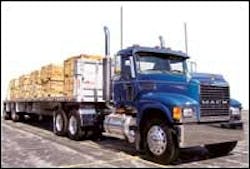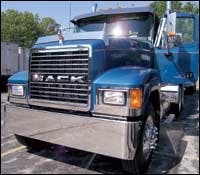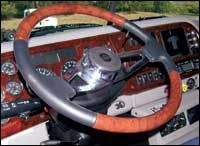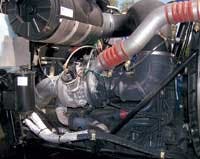Chrome Glints from Mack's Rawhide Tractor
Can you say chrome? Here's another way: "Rawhide." That's the latest iteration of Mack Trucks' CH highway tractor, available with two sleeper sizes and as a non-sleeper "work truck," which we have here. A Rawhide could drive straight from a dealer's lot to a truck beauty show and probably do well in the competition.
Gobs of bright-metal trim adorn its nose, flanks and roof, and highlight details inside the cab. Most of it's actually polished stainless steel and aluminum, which is more durable and easier to care for. And it certainly catches the eye and grabs some attention for the driver, and builds the image of the owner, which is the point of the Rawhide. The package also includes extra noise-reduction insulation and a spiffy interior.
But it's still a Mack, in this case set up for severe-service hauling with an extra-heavy frame that has rails 9.5 millimeters (0.374 inch) thick and 300 mm (11.8 inches) high, and severe-duty crossmembers. That would make it a good on/off-road tractor for pulling an end- or bottom-dump trailer.
Other components include a Meritor 14,600-pound front axle, Mack (made by Meritor) 44,000-pound rears on a Mack air-ride suspension (made by Hendrickson), and a Mack Maxitorque 18-speed transmission. Add in the 12-liter Mack ASET diesel, steel cab, fiberglass nose and a few gallons of fuel and the tractor scaled at 16,760 pounds at the factory, according to Tom Davis, Mack's highway products marketing manager.
It was well suited to pull the load that Davis had arranged, a 48-foot flatbed stacked with 4×6 timbers. He figured the rig's gross weight was close to 80,000 pounds. The rig was parked, ready to go, at the company's headquarters in Allentown, Pa., where he briefed me on the Rawhide's details.
The list of bright-metal trim includes the Texas square bumper, sun visor, headlight visors, quad air horns, cab skirt, grill surround, and trim around the windows and on the doors. Production versions will also come with a stainless-steel-and-woodgrain steering wheel and a chrome-and-woodgrain instrument panel, which weren't on this prototype tractor, but it did have optional stainless-steel quarter fenders.
Davis and John Walsh, Mack's public relations manager, had mapped out a looping trip to and from Interstate 80 to the north, and had programmed audio directions for replay on the stereo's CD. But it was nearly mid-afternoon and I had to catch a plane by early evening, so I instead chose a shorter jaunt: east on I-78 to Route 33, then north to Stroudsburg. There I paused a bit at a truck stop, then returned to Allentown amid some minor rush-hour traffic. That covered only about 110 miles, but it was enough to get acquainted with the truck.
I immediately liked the 460-hp Mack ASET engine. It felt strong in every gear, and stronger than its 1,660-pound-foot rating might suggest. On upgrades, I could lug it down to and below its 1,200-rpm torque peak before it began fading. Only then did the pyrometer show any serious heat in the exhaust, about 600 degrees Fahrenheit; usually the needle seldom got above 300 degrees.
On short but steep upgrades I could make half-gear changes, picking up a couple of hundred revs with a split and seldom needing to make full gear changes. With 4.35 rear-axle gears the tractor wasn't especially long-legged, but I cruised at 60 to 65 mph with the tachometer showing a reasonable 1,575 to 1,650 rpm in top gear (the 18th ratio). At 1,600 to 1,700 rpm the engine makes 487 horsepower, so this is definitely its sweet spot. On downgrades, the PowerLeash engine brake held speeds in check with almost no help needed from the service brakes.
When starting out, I used Low on a few slight upgrades; but otherwise 1st was sufficient to get moving at engine-idle speed, and 2nd was fine if I was rolling at all. I did find it hard to upshift smoothly in Low range and seldom could make a decent downshift while rounding corners in town. An air-assisted clutch pedal made double-clutching otherwise easy. Davis said the hard shifting is common in brand-new Mack transmissions because their stout gears take about 50,000 miles to wear in. This truck had 45,000 to go.
The Rawhide's extra sound insulation was evident when cruising with the windows up. The truck is quiet, with little road noise and just enough engine sound. I couldn't leave my window buttoned up for long, though, because I couldn't get the air conditioner to work. It turns out you have to push the Max A/C button to activate it; a tiny sticker near the controls advises using that button, but I didn't notice that until later. Once going, the A/C worked fine, although there are only two dash vents and air flow seems limited.
This prototype tractor lacked the standard driver's side power window, and it took about a dozen twists of the handle to roll that window up or down. The passenger-side window was powered, but I didn't know that so it stayed up until I got back after a couple of hours on the road. Davis pointed out the switch on the dash (duh!), as well as the A/C operation.
While underway, the variable-geometry turbocharger whistled a delightful tune that I could hear and enjoy but not be annoyed by. The large side windows presented a good view to the outside world, and the West Coast-style mirrors showed clear pictures of what was happening behind. The windshield is big without being huge and the view through it and over the moderately sloped hood is fine, too.
Tuck-and-button upholstery graces the headliner and parts of sleeper interiors, making them classy places to live. In this daycab, the fine interior treatment, which includes rich fabric on the seats and a handsome instrument panel with easy-to-read gauges, makes it an almost fancy place to work. Mack fans should love it.




